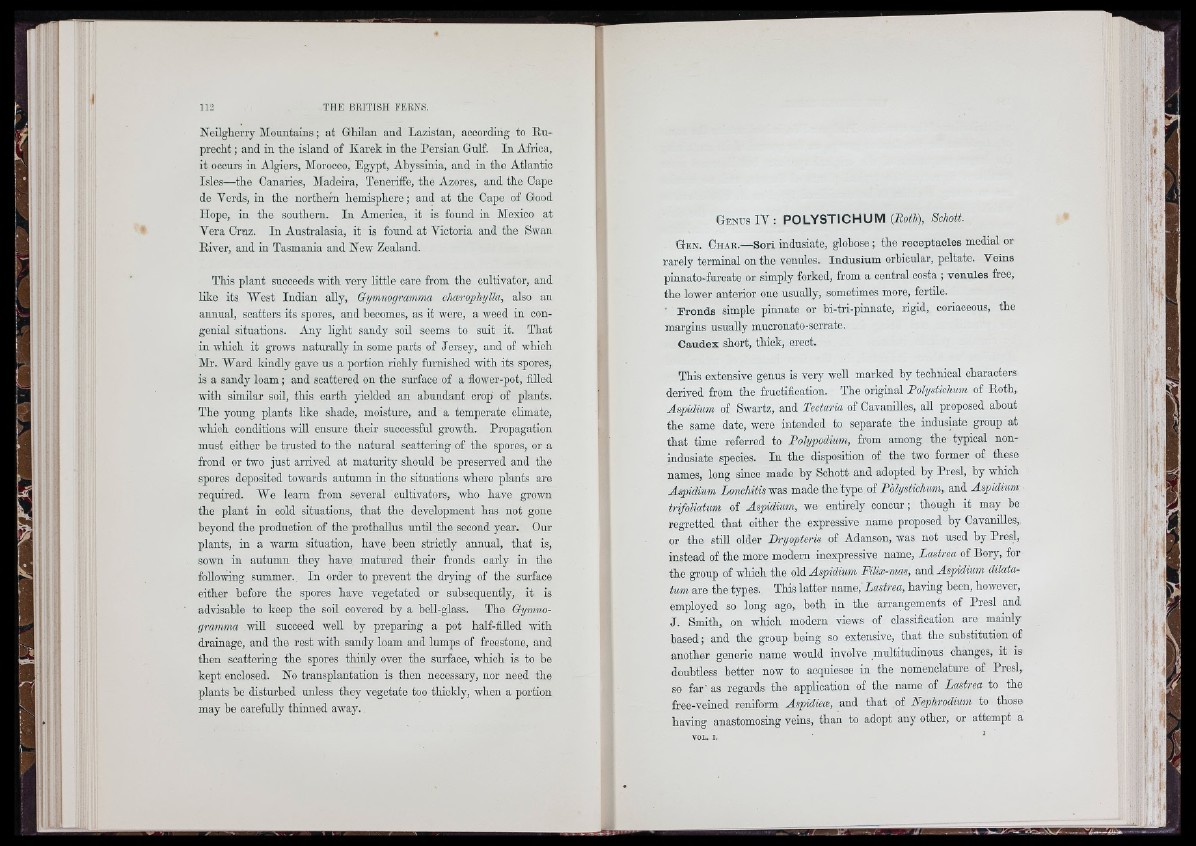
Neilgheri-y Mountains; at Ghilan and Lazistan, according to Ru-
preolit; and in tho island of Karek in the Persian Gulf. In Africa,
it occurs in Algiers, Morocco, Egypt, Abyssinia, and in the Atlantic
Isles—the Canaries, Madeira, Teneriffo, tho Azores, and the Capo
de Vcrds, in tho northern hemisphere; and at the Capo of Good
Hope, in the southern. In America, it is found in Mexico at
Vera Cruz. In Australasia, it is found at Victoria and the Swan
River, and in Tasmania and New Zealand.
This plant succeeds with very little care from the cultivator, and
like its West Indian ally, Gymnogramma chairophylla, also an
annual, scatters its spores, and becomes, as it wore, a weed in congenial
situations. Any light sandy soil seems to suit it. That
in which it grows naturaUy in some parts of Jersey, and of which
Mr. Ward kindly gave us a portion richly furnished with its spores,
is a sandy loam; and scattered on the surface of a flower-pot, filled
with similar soil, this earth yielded an abundant crop of plants.
The young plants like shade, moisture, and a temperate climate,
which conditions will ensure their successful growth. Propagation
must either be trusted to the natural scattering of the spores, or a
frond or two just arrived at maturity should be preserved and the
spores deposited tow'ards autumn in the situations where plants are
required. We learu from several cultivators, who have grown
the plant in cold situations, that the development has not gone
beyond the production of the prothaUus until the second year. Our
plants, in a warm situation, have been strictly annual, that is,
sown in autumn they have matured their fronds early in the
following summer. In order to prevent the drying of the siu’faoe
either before the spores have vegetated or subsequently, it is
advisable to keep the soil covered by a beR-glass. The Gymnogramma
wiU succeed weU by preparing a pot half-filled with
drainage, and the rest with sandy loam and lumps of freestone, and
then scattering the spores thinly over the surface, which is to he
kept enclosed. No transplantation is then necessary, nor need the
plants be disturbed unless they vegetate too thickly, when a portion
may be carefuUy thinned away.
G enus IV ; PO LY ST ICHUM {Roth), Schott.
Gen. Chab.—Sori indusiate, globose; the receptacles medial or
rarely terminal on the venules. Indusium orhioular, peltate. Veins
pinnate-furcate or simply forked, from a central costa ; venules free,
the lower anterior one usually, sometimes more, fertile.
Fronds simple pinnate or bi-tri-pinnate, rigid, coriaceous, the
margins usually mnoronato-serrate.
Caudex short, thick, erect.
This extensive genus is very well marked by technical characters
derived from the fruotifioation. The original Polystichum of Roth,
Aspidium of Swartz, and Tectaria of Cavanilles, all proposed about
the same date, were intended to separate the indusiate group at
that time referred to Polypodium, from among the typical nou-
indusiate species. In the disposition of the two former of these
names, long since made by Sehott and adopted hy Presl, by which
Aspidium Lonchitis was made the type of Polystichum, and Aspidium
trifoliatum of Aspidium, we entirely concur ; though it may be
regretted tbat either tbe expressive name proposed by Cavanilles,
or the stni older Dryopteris of Adanson, was not used hy Presl,
instead of the more modern inexpressive name, Lastrea of Bory, for
the group of which the old Aspidium Fihx-mas, and Aspidium dilata-
tum are the types. This latter uame) Lastrea, having been, however,
employed so long ago, both in the arrangements of Presl and
J. Smith, on which modern views of classification are mainly
based ; and the group being so extensive, that the substitution of
another generic name would involve multitudinous changes, it is
doubtless better now to acquiesce in the nomenclature of Presl,
so far' as regards the apphoation of the name of Lastrea to the
free-veined reniform Aspidiecc, and th a t of Nephrodium to those
having anastomosing veins, than to adopt any other, or attempt a